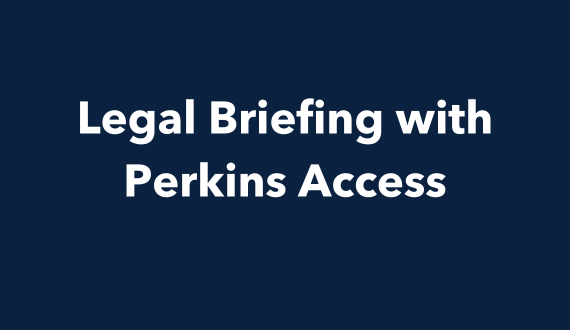What do I need to know about WCAG 2.2?
Share

When do I need to meet WCAG 2.2.?
The Web Content Accessibility Guidelines version 2.2 (WCAG 2.2) reflects several years of work by accessibility experts to update the current version of the guidelines (2.1). WCAG 2.2 is not quite finished, however: it’s still undergoing final review and testing, which means that revisions are still possible. The good news is that WCAG 2.2 doesn’t replace 2.1, it simply expands upon it.
Once WCAG 2.2 is published, which is currently scheduled to happen in early 2023, there is no immediate requirement to conform to the new recommendation. For example, it will take some time for government regulations to be updated to refer to WCAG 2.2. However, companies or academic institutions can update their accessibility policies to require conformance to the new guidelines at any time once the final version of WCAG 2.2 is released, without having to wait for changes to federal regulations.
What’s new with WCAG 2.2?
WCAG 2.2 will likely add nine success criteria to WCAG 2.1, bringing the total number of A, AA and AAA criteria to 87. All criteria from WCAG versions 2.0 and 2.1 will remain in the new recommendation. Although WCAG 2.2 isn’t final yet, now is the time to learn about the new criteria and plan ahead for implementation.
Here’s our easy-to-understand summary of the new criteria as they are currently written:
2.4.11 Focus Appearance (Level AA)
Criterion 2.4.11 governs both the size and contrast of the keyboard focus indicator. This guideline will help ensure that keyboard users can easily see the keyboard focus, as well as determine when a link, button or other control can be activated.
2.4.12 Focus Not Obscured (Minimum) (Level AA) & 2.4.13 Focus Not Obscured (Enhanced) (Level AAA)
Both 2.4.12 and 2.4.13 help ensure that the keyboard focus indicator is not covered by components such as sticky headers or footers. There is a subtle difference between them, however: 2.4.12 permits the focus to be partially obscured, whereas 2.4.13 requires that the focus indicator be completely unobscured.
2.5.7 Dragging Movements (Level AA)
Dragging movements can be difficult for many users, especially those with mobility disabilities. If there’s an interactive component on a page that requires users to drag an object from one place to another, 2.5.7 states that there be an alternative method to perform the same function without dragging. For example, if an activity asks users to click and drag an object from point A to point B, an alternative approach could be to simply click on the object at point A and then click on point B to drop the object there.
2.5.8 Target Size (Minimum) (Level AA)
When it comes to clicking on small buttons or linked images, sometimes it’s hard to get the pointer in exactly the right place. 2.5.8 addresses this problem by specifying a minimum size for clickable objects as well as the space between clickable objects. This will not only make it easier for users to click on the intended control, it will also help avoid selecting an adjacent control by mistake.
3.2.6 Consistent Help (Level A)
If a website includes contact information to get help, that information must be positioned consistently on the site. This means that if an email address, phone number, chat client or social media links are all available in the footer region of a page, they must always appear in the footer, in the same relative order, as users move from one page to the next.
3.3.7 Accessible Authentication (Level AA)
Criterion 3.3.7 deals specifically with cognitive function tests that are required for security purposes (e.g., remembering a username or a password, or interpreting distorted characters and typing them into a text input.) If these types of tests are implemented, there must be an alternative authentication method that does not rely on, say, memorization or transcription. A simple example is a password input that blocks users from pasting text into it, and instead requires that the password always be typed. Allowing users to copy and paste the password from a password manager or a separate document removes the cognitive test (i.e., memorization) from this function.
There are a few exceptions to 3.3.7, one being the use of CAPTCHAs that require users to recognize an object. These are allowed because the objects themselves are generally very familiar, such as stoplights, bridges, buses, etc.
3.3.8 Accessible Authentication (No Exceptions) Level AAA
Criterion 3.3.8 has the same conformance requirements as 3.3.7, but it does not allow for any exceptions, which means the use of an object-recognition CAPTCHA would not conform to 3.3.8.
3.3.9 Redundant Entry (Level A)
When filling out certain kinds of forms, such as those found in a checkout process, it isn’t unusual to have to type the same information multiple times. This can place a burden on users with cognitive disabilities, or anyone for whom typing is difficult or fatiguing. 3.3.9 aims to reduce this burden by requiring that data can automatically be copied or reused. For example, if the shipping address is identical to the billing address, users should be able to type the address into the shipping form and then check a box to copy it into the billing form.
Get help with WCAG 2.2
Perkins Access partners with organizations all over the globe to improve digital accessibility and meet WCAG standards. If you’re ready to embrace digital accessibility, we can help. Get in touch today.




